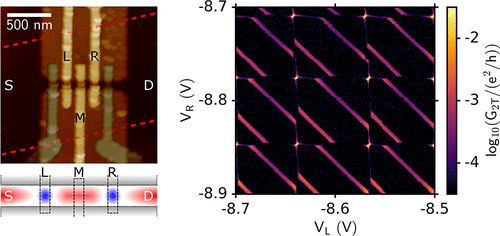当前位置:
X-MOL 学术
›
Nano Lett.
›
论文详情
Our official English website, www.x-mol.net, welcomes your feedback! (Note: you will need to create a separate account there.)
Coupled Quantum Dots in Bilayer Graphene
Nano Letters ( IF 10.8 ) Pub Date : 2018-07-09 00:00:00 , DOI: 10.1021/acs.nanolett.8b01859 Marius Eich 1 , Riccardo Pisoni 1 , Alessia Pally 1 , Hiske Overweg 1 , Annika Kurzmann 1 , Yongjin Lee 1 , Peter Rickhaus 1 , Kenji Watanabe 2 , Takashi Taniguchi 2 , Klaus Ensslin 1 , Thomas Ihn 1
Nano Letters ( IF 10.8 ) Pub Date : 2018-07-09 00:00:00 , DOI: 10.1021/acs.nanolett.8b01859 Marius Eich 1 , Riccardo Pisoni 1 , Alessia Pally 1 , Hiske Overweg 1 , Annika Kurzmann 1 , Yongjin Lee 1 , Peter Rickhaus 1 , Kenji Watanabe 2 , Takashi Taniguchi 2 , Klaus Ensslin 1 , Thomas Ihn 1
Affiliation

|
Electrostatic confinement of charge carriers in bilayer graphene provides a unique platform for carbon-based spin, charge, or exchange qubits. By exploiting the possibility to induce a band gap with electrostatic gating, we form a versatile and widely tunable multiquantum dot system. We demonstrate the formation of single, double and triple quantum dots that are free of any sign of disorder. In bilayer graphene, we have the possibility to form tunnel barriers using different mechanisms. We can exploit the ambipolar nature of bilayer graphene where pn-junctions form natural tunnel barriers. Alternatively, we can use gates to form tunnel barriers, where we can vary the tunnel coupling by more than 2 orders of magnitude tuning between a deeply Coulomb blockaded system and a Fabry–Pérot-like cavity. Demonstrating such tunability is an important step toward graphene-based quantum computation.
中文翻译:

双层石墨烯中的耦合量子点
双层石墨烯中载流子的静电限制为碳基自旋,电荷或交换量子位提供了一个独特的平台。通过利用静电门控来诱发带隙的可能性,我们形成了一种通用且可广泛调谐的多量子点系统。我们证明了没有任何无序征兆的单,双和三量子点的形成。在双层石墨烯中,我们有可能使用不同的机制形成隧道势垒。我们可以利用双层石墨烯的双极性性质,其中pn结形成自然的隧道势垒。另外,我们可以使用门来形成隧道屏障,在这里我们可以通过在深库仑阻塞系统和法布里-珀罗特型腔之间进行超过2个数量级的调整来改变隧道耦合。
更新日期:2018-07-09
中文翻译:

双层石墨烯中的耦合量子点
双层石墨烯中载流子的静电限制为碳基自旋,电荷或交换量子位提供了一个独特的平台。通过利用静电门控来诱发带隙的可能性,我们形成了一种通用且可广泛调谐的多量子点系统。我们证明了没有任何无序征兆的单,双和三量子点的形成。在双层石墨烯中,我们有可能使用不同的机制形成隧道势垒。我们可以利用双层石墨烯的双极性性质,其中pn结形成自然的隧道势垒。另外,我们可以使用门来形成隧道屏障,在这里我们可以通过在深库仑阻塞系统和法布里-珀罗特型腔之间进行超过2个数量级的调整来改变隧道耦合。



























 京公网安备 11010802027423号
京公网安备 11010802027423号